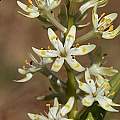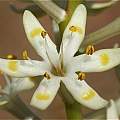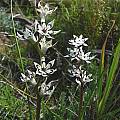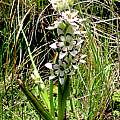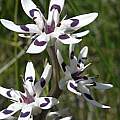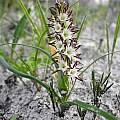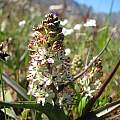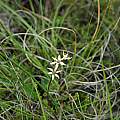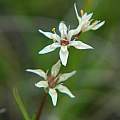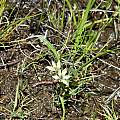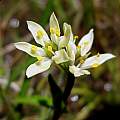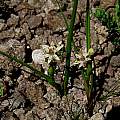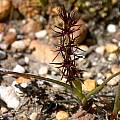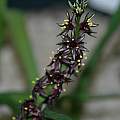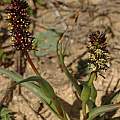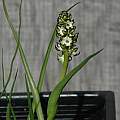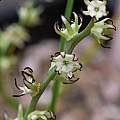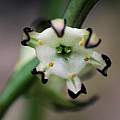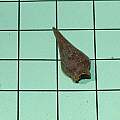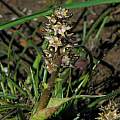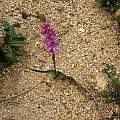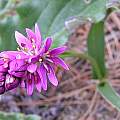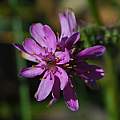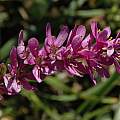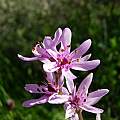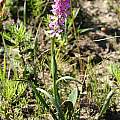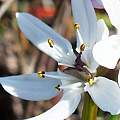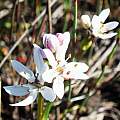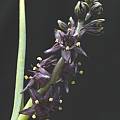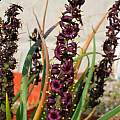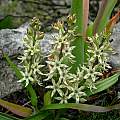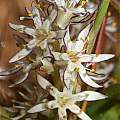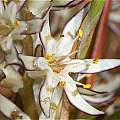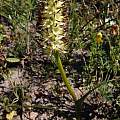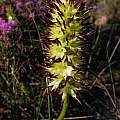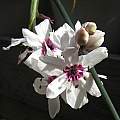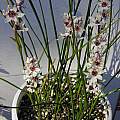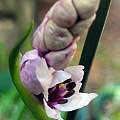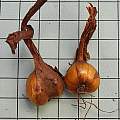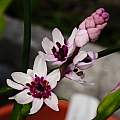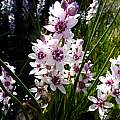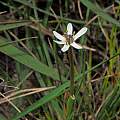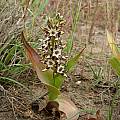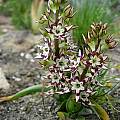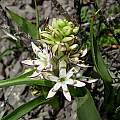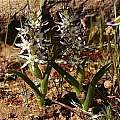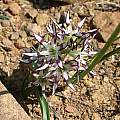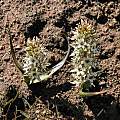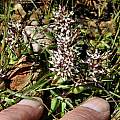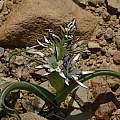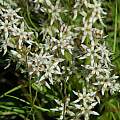Wurmbea is a genus is the Colchicaceae family from sub-saharan Africa and Australia. Plants are found in both summer and winter rainfall areas. The rootstock is a corm and flowers are star or trumpet-shaped. Many of them are pollinated by flies and are therefore sometimes unpleasantly scented. J.C. Manning & Vinn., Taxon 56: 177 (2007) have recommended that Onixotis, a genus with two species, be included in Wurmbea. The main difference is that the tepals of spent flowers drop off in Onixotis.
Wurmbea dolichantha B.Nord. is found on sand and clay in the northwest Cape, South Africa. This species grows from 10 to 30 cm high and has lanceolate leaves and white or cream spreading tepals with a yellow to green spot in the middle of each tepal that turns dark with age. The flower tube is as long or longer than the tepals. It blooms from September to October and has a fetid smell. Photos were taken in habitat by Andrew Harvie in the Western Cape, South Africa.
Wurmbea elatior B.Nord. is found in marshes or streambanks in the Eastern Cape of South Africa (summer rainfall). It has white flowers with shiny deep red to purplish black marks in the middle of the tepals. Height range: 30-45 cm. Photos by Cameron McMaster and Bob Rutemoeller were taken at Naude's Nek in the Drakensberg Mountains.
Wurmbea hiemalis B.Nord. is found on damp sandy slopes in the southwestern Cape of South Africa. It is a fall to winter bloomer with white flowers with purple or black margins and tepals about as long as the tube. Plant grows 4-15 cm high. The photo was taken by Rachel Saunders on the Cape Peninsula near Kommetjie June 2011.
Wurmbea inusta (Baker) B.Nord. is found on damp gravelly flats in the Western Cape of South Africa (winter rainfall). It has broad sheathing linear to lanceolate leaves and greenish or cream flowers with purple margins and bands above the nectaries. Flowers are fragrant. Height: 5-20 cm. Photo from iNaturalist taken by hof59 in the Voëlvlei Nature Reserve in September and Jane Nicols in Elandsberg in September and shared under a CC BY-NC license.
Wurmbea kraussii Baker is a small plant to 10 cm found on damp places in grassy slopes in the Eastern Cape, South Africa (summer rainfall). It has one narrow basal leaf enclosing the stem in a basal sheath and white or pink flowers. Photos were taken in January near Maclear and Naude's Nek in the Drakensberg Mountains by Mary Sue Ittner and Cameron McMaster.
Wurmbea marginata (Desr.) B.Nord. is found on mostly clay or loam in the renosterveld in the western and southern Cape of South Africa (winter rainfall). It is red or purple with darker margins and foul smelling. Flowers are crowded on the stalk and tepals are spreading. Height: 6-22 cm. The first photo by Cameron McMaster was taken in habitat in Napier in the Overberg. The second photo was taken by Bob Rutemoeller at a bulb symposium sponsored by the Indigeneous Bulb Association of South Africa. The last photo was taken by Rod Saunders.
Wurmbea monopetala (L.f.) B.Nord., a species from 15 to 25 cm, is found on damp flats and lower slopes on sandy or gravelly soil in the Western Cape, South Africa (winter rainfall). Leaves are narrowly lanceolate and flowers are in a lax spike, greenish or cream with dark margins. The tepals are well separated at the bases. Photos 1-4 from Mary Sue Ittner from what she thinks is this species that was received as seed that was supposed to be Wurmbea punctata, but is not that species. It bloomed reliably for a number of years for several months starting in late winter with the flowers opening close to each other, but the distance on the stalk lengthening as time passed as the photos show. The fourth photo shows the corms on a 1 cm grid. The last photo, also taken by Mary Sue Ittner, shows this plant in habitat near Villiersdorp August 2006.
Wurmbea punctata (L.) J.C.Manning & Vinn., syn. Onixotis punctata (L.) Mabb., syn. Dipidax punctata (L.) Hutch., grows on damp sandstone and clay slopes in winter rainfall areas of South Africa (from the Bokkeveld Mountains to Swellendam) and has white to maroon flowers, sessile in short spikes. The styles are free. It has three lanceolate unsimilar leaves with the uppermost set about halfway up the stem. Plants grow from 10 to 20 cm and flowering time is July-September. The first two pictures of plants growing in the wild near Paarl were photographed in September 2003 by Bob Rutemoeller. The next two photos were taken near Tulbagh by Mary Sue Ittner. The fifth photo was taken by Cameron McMaster in the Overberg and the last by Andrew Harvie.
The first two photos were on the Mystery Bulb page and were supplied by Bruce Bayer of plants growing in Fisherhaven, South Africa. They were tentatively identified by Christopher Whitehouse as one of the former Onixotis species since the tepals were free at the base and not in a tube and as this species is usually smaller than the other species. Wurmbea stricta grows in pools and marshes and has pink flowers with dark bases. The leaves are also different. The last photo is from Rod Saunders.
Wurmbea recurva B.Nord. is a South African species from the northwest and southwest Cape (winter rainfall) where it is found on damp gravelly slopes in renosterveld. It blooms in spring and has a honey scent. The inflorescence is about 6 cm in height. It has red-purple-brownish tepals that are bent backward. Photographs from Mark Mazer and Alan Horstmann.
Wurmbea spicata (Burm.f.) T.Durand & Schinz is found on mostly clay and granite slopes in renosterveld in many areas of the Cape Province, South Africa (winter rainfall). Growing to 20 cm tall, it has lanceolate, erect leaves, some folded around the stem and inflated to form a small beaker that channels rainwater to the roots. Flowers are densely crowded at the top of the stem, white to cream, and sometimes with dark reddish purple margins. The first photo by Cameron McMaster was taken at Caledon in the Overberg. Photos 2-3 were taken by Andrew Harvie in the Roggeveld Mountains. The last two photos from the book Plants of the Klein Karoo courtesy of Jan and Anne Lise Schutte-Vlok.
Wurmbea stricta (Burm.f.) J.C.Manning & Vinn., syn. Onixotis stricta (Burm.f.) Wijnands, syn. Onixotis triquetra (L.f.) Mabb., syn. Dipidax triquetra (L.f.) Baker, is found growing in marshes and pools in the northwest and southwest Cape, South Africa (winter rainfall). It is reliable and easy to grow in a pot in a Mediterranean climate, and is hardy in mild frosts. Height to 0.6 m. It has dark green channeled similar leaves with the upper two clasping, set just below the spike and star-shaped pale pink flowers with a maroon center. Styles are united. One distinctive feature of this genus is that the flowers emerge from a bulge on the plant stem some distance above the ground (this can be seen in the second photo). Photo by Bob Rutemoeller of plants grown from seed and blooming February 2003 in Northern California. Photos 2-5 by Mary Sue Ittner. The last of hers show the corm on a 1 cm grid. The last photo by Michael Mace shows the corncob-like arrangement of the buds. Some people grow this plant with a saucer of water underneath it. It can also be added in a pot to a water garden and then moved to dry storage in the summer.
The first two photos were taken by Cameron McMaster September 2011 near Nieuwoudtville. It is often massed in areas where it is happy as in the first photo. The last photo was taken by Rod Saunders.
Wurmbea uniflora (R.Br.) T.D.Macfarl. is an Australian species that is widespread in moist to wet areas in open forest, swamps and grasslands in a number of states. It grows from 4 to 15 cm. and has 1 to 2 upward facing white flowers and blooms in spring. Photo taken by Mary Sue Ittner in the Grampians, Victoria. Distribution extends south across Tasmania. (source AVG Australia's virtual herbarium).
Wurmbea variabilis B.Nord., a species from 5 to 20 cm high, is found on sandy flats in the Western Cape, Western Karoo and the Eastern Cape (South Africa). It has ovate to lanceolate leaves, greenish or cream flowers with purple nectaries, a dark blotch and sometimes purple margins and an unpleasant smell. Photos by Cameron McMaster were taken at Napier, Caledon and in the Komsberg. The last photo was taken by Alan Horstmann.
Photos 1-3 below from Bob Rutemoeller were taken in the Little Karoo, Villiersdorp, and Middelpos. The last photo from Mary Sue Ittner also taken at Villiersdorp was first thought to be Wurmbea spicata but John Manning thinks it is a form of this species with lighter blotches or perhaps a hybrid.
